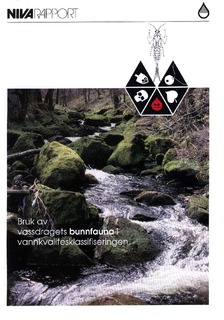| dc.contributor.author | Aanes, K. | nb_NO |
| dc.contributor.author | Bækken, T. | nb_NO |
| dc.contributor.other | Aanes, K. - Project manager | nb_NO |
| dc.coverage.spatial | Norge | nb_NO |
| dc.date.accessioned | 2014-08-01T10:38:31Z | |
| dc.date.available | 2014-08-01T10:38:31Z | |
| dc.date.issued | 1995 | nb_NO |
| dc.identifier | 3338 | nb_NO |
| dc.identifier.isbn | 82-577- | nb_NO |
| dc.identifier.issn | 1894-7948 | nb_NO |
| dc.identifier.uri | http://hdl.handle.net/11250/208505 | |
| dc.description.abstract | Norwegian watercourses are becoming increasingly acidified. Small animals on the river bottom can be used to classify the biological damage caused by acidification, The report describes the classification systems developed by Raddum and by Engblom/Lingdell. Both systems are based on the presence or absence of indicators that give index values, depending on their tolerance to acidification. Experiments confirm the hypothesis that brief acidification episodes can cause serious reductions in a macroinvertebrate community. Standardised tests showed the macroinvertebrates' tolerance to acid water pH), acid water containing labile aluminium and acid water containing humus. In general, the mayfly species were most sensitive to acid water, followed by the stoneflies. The caddis flies were most tolerant. Aluminium had a favourable effect on the survival of the mayfly Baetis rhodani at low pH. Humus had a favourable effect on the survival of Baetis rhodani and the amphipod Gammarus lacustris in an acid environment. Based on Raddum's and Enghlom/Lingdell's systems, other Nordic publications and our own field and experimental data, NIVA proposes a set of indicators that will be valid for investigations of acidification in most Norwegian watercourses. The water quality is distributed between classes 1-4, where 1 expresses no acidification damage and 4 expresses a locality severely damaged by acidification. | nb_NO |
| dc.description.sponsorship | Statens forurensningstilsyn (SFT) Norsk institutt for vannforskning (NIVA) | nb_NO |
| dc.publisher | Norsk institutt for vannforskning | nb_NO |
| dc.relation.ispartofseries | NIVA-rapport;3338 | nb_NO |
| dc.rights | Navngivelse-IkkeKommersiell-DelPåSammeVilkår 3.0 Norge | nb_NO |
| dc.rights.uri | http://creativecommons.org/licenses/by-nc-sa/3.0/no/ | nb_NO |
| dc.subject | eutrofi | nb_NO |
| dc.title | Use of macroinvertebrates to classify water quality. Report No 2 A: Acidification | nb_NO |
| dc.type | Research report | nb_NO |
| dc.rights.holder | Norsk institutt for vannforskning/Norwegian institute for water research | nb_NO |
| dc.subject.nsi | VDP::Matematikk og naturvitenskap: 400 | nb_NO |
| dc.source.pagenumber | 47 | nb_NO |
| dc.subject.keyword | bunnfauna | nb_NO |
| dc.subject.keyword | forsuring | nb_NO |
| dc.subject.keyword | klassifisering | nb_NO |
| dc.subject.keyword | vannkvalitet | nb_NO |
| dc.subject.keyword | water quality | nb_NO |
| dc.subject.keyword | macroinvertebrates | nb_NO |
| dc.subject.keyword | acidification | nb_NO |
| dc.subject.keyword | classification | nb_NO |
| dc.relation.project | | nb_NO |


